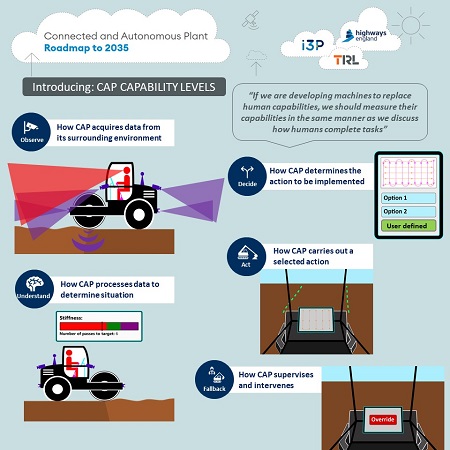This document presents a taxonomy for classifying the capability of construction plant for automated operation. This addresses a key activity identified in the CAP Roadmap (2019) for Connected and Autonomous Plant as Business as Usual by 2035, (TRL, i3P, Highways England, 2020). Following a review of the application of levels across several industries, we have proposed that the principle of “when creating machines which are intended to replace human capability, they should be assessed using the same language we ;use to assess human capability” should be applied to CAP. This approach is more complex than “wrapped-up” taxonomies applied in industries such as automotive, but it reflects the higher level of complexity required to define the wide range of activities undertaken by plant. It also provided for flexibility and is amenable to the re-classification of plant after retrofitting.
We have therefore proposed a set of levels that adopt the 4-stages of information processing that describe human and automated capability across the full process of executing a task. Discrete levels have been established to describe how any stage of processing becomes increasingly automated. The development of the levels has avoided prescribing different technological solutions to achieving a certain level of automation, with the importance being placed on the degree of human intervention required at any point.
Supporting the taxonomy, we have included an extensive ;discussion around Operational Design Domain. This is a key component that must be included when discussing the capabilities& of plant, as the capability of technology may depend on the ;specific environment in which it is being applied. Also reflecting practice in other industries, the levels include a Fallback and Responsibility stage. This reflects the need for clearly defined expectations about the role of plant and people when a machine begins to operate outside of its capability, or ODD.
Following the development of the levels, we have attempted to provide clarity on how the levels could be used in the construction ;industry through specific examples of their application to the tasks ;of compaction and excavation. We have also highlighted how ;they levels could be applied by different stakeholders within this industry to support technical, strategic, legislative, and contractual development. Our use cases are illustrative and in no way exhaust the potential uses that will hopefully occur as the levels are adopted across the sector. ;
Although this document has provided a complete taxonomy, it is ;expected that, as the levels are applied within the industry and further developments are made, there will be a need to update and refine the levels to adapt to the evolving context of the industry. As such, this document effectively represents a “public beta version” of the levels. We encourage trials of the levels by the intended end users to understand their content, fitness of purpose, complexity, suitability etc., which will hopefully lead to refinement and wider application across the industry.

